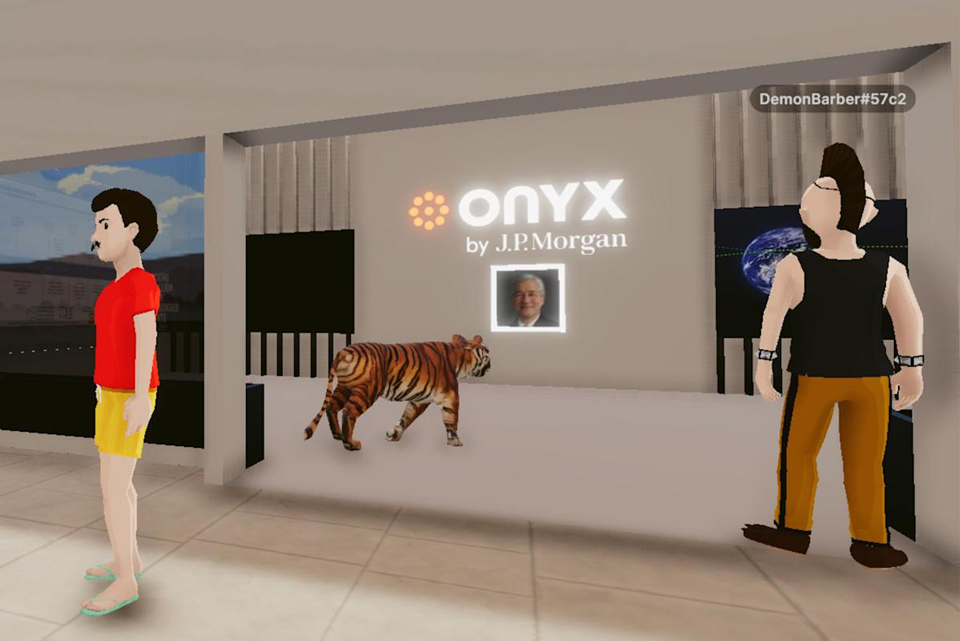For someone who has just paid the cryptocurrency equivalent of $1.2 million for a plot of virtual real estate in the metaverse, Jason Rosenstein, chief executive of Portion, a digital art auction house, surprises Euromoney.
More on the metaverse
He sounds as if he knows exactly what he is doing.
Rosenstein specializes in cryptography. He has been working on the blockchain since 2011, focusing on non-fungible tokens (NFTs) since 2016, which led him to invest in Decentraland in 2017.
That’s the metaverse where Rosenstein bought his plot in February.
He has seen scarcity first in bitcoin, with its finite supply, then in NFTs, which hit the headlines in 2021 after Christie’s auctioned the artist Beeple’s NFT of ‘Everydays: The first 5,000 days’ for the Ether equivalent of $69.35 million.
“I remember presenting to investors in 2017 and telling them I thought cryptocurrency collectibles could become a $2 billion-a-year market,” Rosenstein tells Euromoney. “In 2021, there was £22 billion in sales of digital art and collectibles. It has already exceeded everyone’s imagination.”
It has already exceeded everyone’s imagination
Jason Rosenstein, Portion

Two things happened. First Covid locked down a lot of artists and performers, who began to focus on the digital world as a means of expression and a way to get paid. Then Facebook announced its rebranding as Meta and its intention to become a metaverse company rather than a social-media network.
What might have developed over a decade happened much faster.
Rosenstein now sees a scarcity of land in premier metaverse locations. The analysis is akin to that for buying or leasing property in the real world, for example of foot-traffic driven by people visiting other locations nearby.
Just as premier anchor tenants attract consumers and other businesses into malls and shopping centres in the real world, so it works in the metaverse.
Rosenstein patiently explains why people come to Decentraland, which looks to Euromoney like a clunky version of Tomb Raider from the mid 1990s.
That is because it is not a gaming metaverse. Sandbox has more of a gaming feel. Rather, people come to Decentraland for events, such as concerts, typically accompanied by drops of NFTs that users love to collect. “Concerts could be one of the biggest things that draw more people into the metaverse,” Rosenstein says. “We’ll be announcing something with a major band soon.”
This is why businesses have to buy or rent land in the popular metaverses. The technology is such that businesses could build their own, but that is no good if nobody comes there.
Rosenstein says: “There are a handful of social networks – TikTok, Facebook, Twitter. It’ll probably be the same with metaverses. And businesses should diversify. They shouldn’t just be in one.”
Did Rosenstein take out a mortgage to buy his plot, Euromoney wonders. “No mortgage,” he says. “I put down all cash up front and got the land immediately from the secondary seller.” It was not Decentraland selling.
It’s simpler than people make it out to be. It just mimics the real world
Jason Rosenstein
Why is he confident this was a good use of his cash?
“Because we are getting tremendous outreach from all kinds of big companies that want to activate their brands in the metaverse,” Rosenstein explains. “This is a goldrush. Big companies want to set up storefronts. You’re even seeing auto companies looking to set up dealerships in the metaverse.”
It is a bit like buying Superbowl ads.
“But they’re not looking to monetize these investments in the metaverse immediately,” Rosenstein says. “They just want to establish a presence for their brands there.”
In JPMorgan’s ‘Opportunities in the Metaverse’ report, it lists Walmart, Nike, Gap, Verizon, Hulu, PWC, Adidas and Atari, among others, taking this approach.
Euromoney had forgotten Atari, founded in 1972 and maker of the first video game Pong, a basic form of electronic tennis. It is reborn on the blockchain and in the metaverse, establishing itself to Generation Z as a maker of metaverse arcade games to play in a crypto-casino while waiting for that Travis Scott show.
Collector base
Portion’s core business, its art auction house, continues to grow. It recently hosted an exhibition of afro-futurism digital art with many pieces on sale for less than one ether ($2,720).

Tenderly by Maxwell Dewunmi, for example, is listed for Eth 0.6 or PRT 246,736. That’s $1,625 of your regular dollars.
“The collector base is expanding rapidly,” Rosenstein says. “Everyone hears about those million-dollar NFT sales but, just as in the real world, only a tiny percentage of artists command those prices. There are thousands and thousands of artists creating NFTs, and more and more wallets are holding them.”
Portion is also the name of the company’s own cryptocurrency – PRT on the crypto exchanges – in which artists are paid. Rosenstein hopes to encourage something of a circular economy, with artists using their portion-denominated earnings to buy other items.
The venture to help much bigger companies build their brands follows the announcement of a partnership with Publicis Sapient, a digital consultancy. It is this business that he sees justifying the $1.2 million spent on virtual real estate.
“I’ll probably make that money back in six months just from all the brands that want us to build their presences for them, and I may even be able to sell the land in a few years for 10 times what I paid for it,” says Rosenstein. “With the brands on it, we’re going to see a process of digital gentrification in the metaverse.”
There is a big bet here, however: that the much-touted metaverse technology of augmented and virtual reality makes it easy for people to access the kind of hybrid experience where being in the metaverse, for example at a concert, is almost like being at Madison Square Garden or Brixton Academy.
“The technology delivering is already priced in,” Rosenstein agrees. Euromoney cannot help wondering if it will.
And a more fundamental technology also needs to improve: moving money in the metaverse, which, so far, is all over blockchain and with cryptocurrencies.
The user experience is dire – even worse than in fiat currency – and everybody in the crypto world knows it, even if they rarely admit it. The friction costs, such as Ethereum gas fees, are high. Exchange rates are volatile, making many cryptos a poor medium of exchange. Security worries are constant, from losing your cryptographic keys and access to your own wallet and everything in it – Portion advocates cold storage offline – to having cryptos stolen on the bridges between blockchains.
The coming upgrade of Ethereum will help, Rosenstein says.
“Moving to proof-of-stake should help limit gas fees. In three years, it won’t be like this. Sending money, or NFTs, on blockchain really will be like sending an email. Maybe at the start of email, people marvelled at the internet protocols beneath it all. Now they just press ‘Send’. It will be the same with crypto.”
He is a believer in the aspects of the sharing economy that blockchain enables in the metaverse. Rosenstein is a fan of Star Atlas, for example, and has a small fleet of spaceships together worth $100,000.
“When you’re not in Star Atlas, you may want to rent out your spaceship or your mining assets to others who will pay to use them,” he says. “You can charge so much an hour and time lock the rental, say for six hours, with a smart contract. That’s the power of the blockchain.”
The blockchain works in the more prosaic realm of debt capital markets for example, as well as in the virtual world. Rosenstein’s parting thought to Euromoney is not to over-complicate the economics of the metaverse.
“It’s simpler than people make it out to be,” he says. “It just mimics the real world.
“That’s why it works.”






